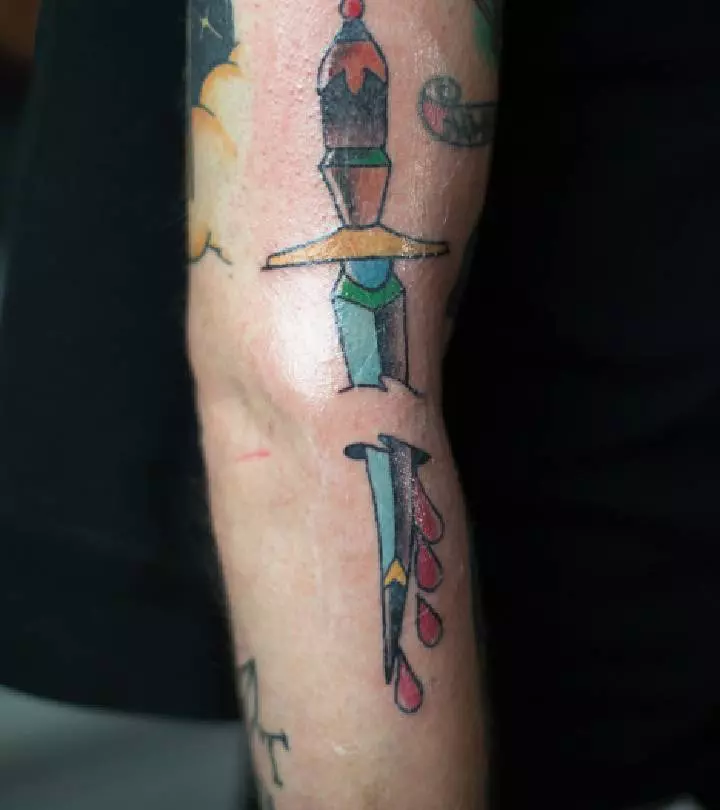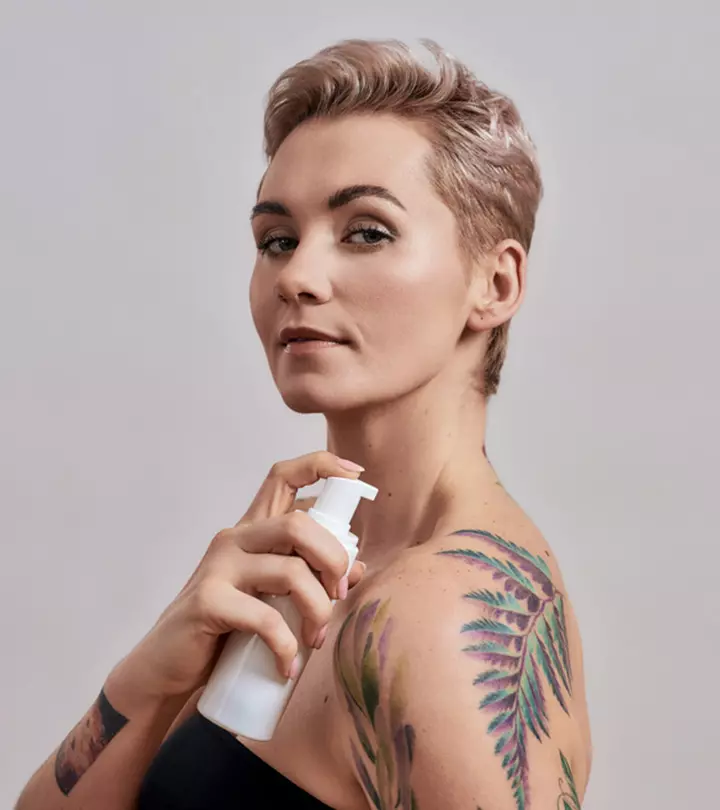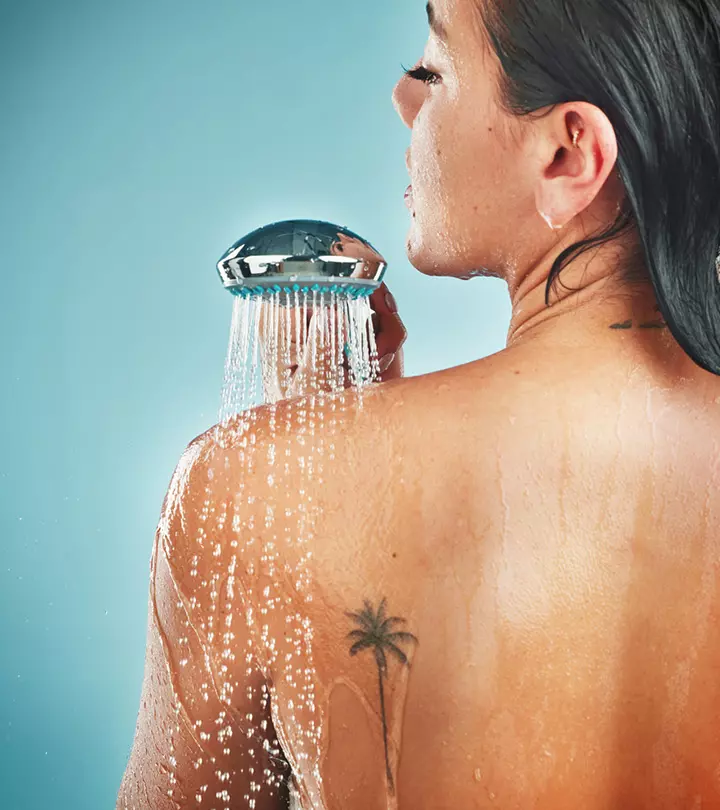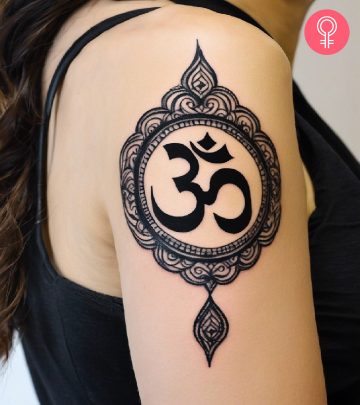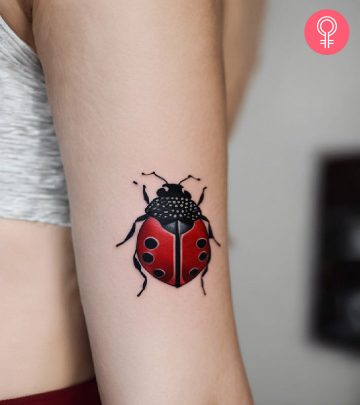Tattoo Scabbing: Is It Normal? How To Prevent It
Every wound develops a scab and tattoos are no different.

Image: Shutterstock
Tattoo scabbing is an essential phase in the intricate art of body ink. As your skin undergoes the healing process post-tattooing, a natural defense mechanism triggers the formation of scabs over the freshly tattooed area. These scabs serve as a protective shield, guarding the skin from potential infections and aiding in the regeneration of tissue. It’s crucial to resist the urge to pick or disturb the scabbing tattoo. Some flaking and mild itching is part of the normal healing journey. Understanding the significance of tattoo scabbing is key to ensuring proper aftercare. It also allows you to appreciate the evolution of your fresh tattoo as it transforms into a permanent and vibrant piece of self-expression. Read on to learn more!
In This Article
Why Is My Tattoo Scabbing?

Tattoo scabbing is a natural part of the post-ink healing process. It is indicative of your body’s efforts to regenerate and protect the newly tattooed skin. Several factors contribute to this phenomenon, influencing the intensity and duration of scabbing. Let us look at what causes the scabbing.
- Needle trauma: The tattooing process involves needles puncturing the skin, which causes micro-injuries that trigger the scabbing response.
- Depth of tattoo: Deeper tattoos may result in more extensive scabbing as the body works to repair deeper layers of the skin.
- Skin sensitivity: Individuals with sensitive skin may experience more pronounced scabbing due to their skin’s heightened reaction to the tattooing process.
- Aftercare practices: Inadequate aftercare practices, such as insufficient moisturization and extreme sun exposure, can lead to increased scabbing.
- Immune response: Your body’s immune system can also play a role in naturally forming thicker scabs as part of their healing process.
- Friction: Engaging in activities that cause friction or trauma to the healing tattoo, such as wearing tight clothing, can intensify scabbing.
- Allergic reaction: Thick scabbing may also occur if you have an allergy to tattoo ink, which may increase the risk of a tattoo infection. It is best to seek assistance from a medical professional in this case.
 Quick Tip
Quick TipWhile we learned scabbing occurs due to a natural response of the skin as it repairs itself, further insights into the process are required to help us understand what is normal and what is not. Scroll down to the next section to learn more about it.
Is It Normal For Tattoos To Scab?

It is entirely normal for your tattoos to undergo scabbing as part of the natural healing process. When you get a tattoo, the needles penetrate your skin and cause micro-injuries. In response, your body forms protective scabs over the tattooed area. These scabs shield the skin and allow it to regenerate and repair. Scabbing is a temporary phase that usually occurs after getting inked, and it may cause some itching. While it might be tempting to pick or disturb the scabs, resist the urge to do so as this could interfere with the healing process. A tattoo scab is the same as any scab that might occur after an injury to the skin as a tattoo is also a fresh wound on the skin.
Jade, a blogger, shares her experience of caring for her new tattoo while recalling her sister’s not-so-good tattoo healing experience. She writes, “Mine however was pretty much healed within a week. The scabbing had flaked off, and it was a bit itchy but it looked good (i).” She continues, “Looking back on my sister’s experience, I don’t think the tattoo was infected, but she definitely had a bad reaction and had to go on antibiotics.”
Although scabbing needs to happen for your tattoo to heal, there are different types of tattoo scabbing, and each requires a different kind of attention. To know which type of scabbing is forming on your skin during the healing process, check out the next section.
Types Of Tattoo Scabbing
Tattoo scabbing can manifest in various forms, each offering insights into the healing process. Understanding the types of tattoo scabbing can help you navigate the post-ink phase more confidently. Some of them are mentioned below.
- Light flaking: Minimal, light scabbing or flaking is common, especially with smaller tattoos or those with less intricate designs. It indicates a mild healing response.
- Normal tattoo scabbing: A thin, light layer of scabs or flakes that form a protective layer over the tattoo indicates a typical healing process and is part of the body’s natural response to the tattooing trauma.
- Abnormal tattoo scabbing: Thick, raised, or heavier scabs that cover a large portion of the tattoo may indicate issues such as infection, an allergic reaction, or improper aftercare.
- Healthy tattoo scabbing: Moderate scabbing that covers the tattoo evenly, with no signs of infection. It may include thicker scabs in areas where the skin was more stressed during the tattooing.
- Spotting: Some tattoos exhibit tiny spots or speckling of scabs. This can occur when the needle penetrates the skin at different depths.
- Localized tattoo scabbing: Uneven scabbing can also occur as some areas of the skin may be more sensitive or subject to greater trauma during the tattooing process than others.
As you can see, different types of scabbing manifest differently. If you want to learn how to take care of the skin before getting a tattoo and after a natural scabbing, check out the next section.
Tattoo Scabbing: Before And After

After getting a tattoo, light scabbing typically emerges 8-24 hours later, signifying the start of the healing process. This initial phase involves delicate scabs forming over the inked area. Over the following days, scabbing may intensify and become more noticeable until the skin heals completely. It is crucial not to pick or scratch during this stage to prevent damage to the tattoo. As the healing progresses, excessive scabbing diminishes, aided by consistent aftercare practices such as gentle cleansing and moisturizing. By diligently following post-tattoo instructions, the scabs gradually fade, revealing clear, vibrant inked skin.
You must look for ways to prevent excessive scabbing while keeping the tattoo clean as the amount of scabbing can affect the results. Check out the next section to learn how to do that.
How To Prevent Scabbing

Tattoo scabbing is a natural part of the healing process, but proper aftercare can minimize its intensity. Follow these steps to prevent excessive scabbing:
- Use a mild, fragrance-free, antibacterial soap and warm water to clean the tattooed area. Gently pat it dry with a clean paper towel. Avoid harsh scrubbing and using hot water.
- Apply a thin layer of the recommended tattoo ointment or unscented lotion 2-3 times a day to keep the skin hydrated. Do not apply a lot of antibiotic ointment or lotion and avoid over-moisturizing as it can cause tattoo bubbling.
- Steer clear of prolonged water exposure by avoiding baths, tubs, or swimming pools to prevent overhydration of the tattooed skin.
- Shield the tattoo from direct sunlight as the UV rays cause damage to the tender skin that may worsen the scabbing.
- Wear loose clothing to prevent friction and rubbing against the healing skin. Opt for comfortable and breathable fabrics while your tattoo heals.
- Resist the temptation to pick or scratch scabs. Allow them to naturally fall off as part of the healing process.
 Quick Tip
Quick TipNow that you know how to properly care for your scabbing tattoo, you can make changes to your tattoo aftercare routine accordingly to prevent common risks. Check out the next section to find out what they are.
Risks Of Tattoo Scabbing
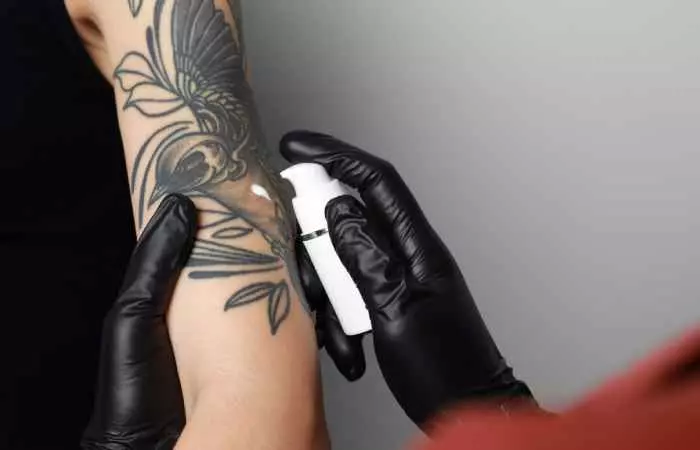
Tattoo scabbing is a common and usually harmless part of the healing process, but improper care can pose risks and lead to complications. They are as follows;
- Infection: Scratching or picking at scabs increases the risk of introducing bacteria, leading to infections.
- Color fading: Aggressive scab removal can pull out ink, causing patches of color loss or uneven healing.
- Scarring: Intense scabbing may lead to raised or textured scars.
- Prolonged healing: Inadequate aftercare can extend the healing period, delaying the emergence of the tattoo’s final, vibrant appearance.
No matter the risks a healing tattoo scab may pose, you must learn to differentiate between a normal scabbing and symptoms that may indicate an infection. Check out the next section for more details.
Normal Tattoo Scabbing Vs. Infection
Distinguishing between normal tattoo scabbing and infection is vital for ensuring a healthy healing process. Normal scabbing is a typical response to the tattooing process. During the process, thin, light, flaky skin layers form to protect the tattooed area during skin regeneration. While some mild itching or discomfort is expected, these symptoms gradually subside.
In contrast, an infection presents itself with more severe symptoms, such as intense pain, excessive redness, and swelling that extend beyond the tattoo borders and are often caused by bacteria or viruses (1), (2). The presence of pus or any foul-smelling discharge is a clear sign of infection. Additionally, systemic symptoms such as fever, abnormal shivering, and excessive sweating are telltale signs of an infected tattoo and require immediate medical attention. Monitoring these signs enables timely intervention. Following tattoo aftercare instructions can help in safeguarding both the tattoo and your overall well-being.
It is important to recognize the phases of normal tattoo scabbing as it is an essential step to ensure a smooth healing process. The initial appearance of thin, light scabs is part of the body’s natural response to the tattooing trauma. While variations may occur, embracing these changes as part of the journey enhances your appreciation for tattoo art. Trusting the body’s innate ability to regenerate the skin fosters a positive mindset during the healing period. Remember, each tattoo healing experience is unique, and patience is key. Allow the scabs to naturally fall off and eventually reveal the vibrant, permanent artwork underneath. If you feel that you still need some reassurance, reach out to a tattoo professional or a medical healthcare professional who will help guide you through your tattoo healing journey.
Frequently Asked Questions
What to put on the skin after the scab falls off?
After a scab falls off, apply a thin layer of a mild, unscented moisturizer to keep your skin hydrated and avoid. Avoid heavy lotions or ointments to aid in the process of healing.
How long does tattoo scabbing last?
Tattoo scabbing typically lasts around 1-2 weeks and requires a little bit of extra care before completely healing from the outside in 2-3 weeks. It varies based on factors such as tattoo size, location, and individual healing processes.
What is the difference between tattoo scabbing and peeling?
Tattoo scabbing is the formation of protective layers on the skin as a wound heals, whereas peeling is the shedding of dead skin. Scabbing protects the healing tattoo while peeling signifies the final stages of skin renewal.
What is the difference between tattoo scabbing and bubbling?
Tattoo scabbing is the formation of protective layers during healing while bubbling refers to blister-like formations on the skin caused by over-moisturization or exposure to excessive moisture.
Do tattoo scabs come off when washing?
Yes, there is a chance of the scabs coming off under direct water pressure which may not help with the healing process. Gently cleanse the tattooed area with mild, fragrance-free soap using lukewarm water and pat it dry to avoid disrupting the healing process.
What stage of tattoo is scabbing?
Scabbing is a normal stage in the later phases of the tattoo healing process, typically appearing a few days after getting the tattoo. It’s part of the body’s natural healing response to the tattooing process.
Do tattoos fade after they scab?
Tattoos may appear faded during the scabbing phase due to the protective layer, but once scabs naturally fall off and healing is complete, the vibrancy usually returns.
Key Takeaways
- Scabs serve as a protective layer, preventing infections and promoting skin regeneration.
- Picking at scabs can lead to scarring and negatively impact the final tattoo outcome.
- Healing times for scabbing vary based on factors like tattoo size and location.
- Diligently follow the aftercare instructions recommended by your tattoo artist to avoid excessive scabbing.
Illustration: Tattoo Scabbing: Is It Normal? How To Prevent It
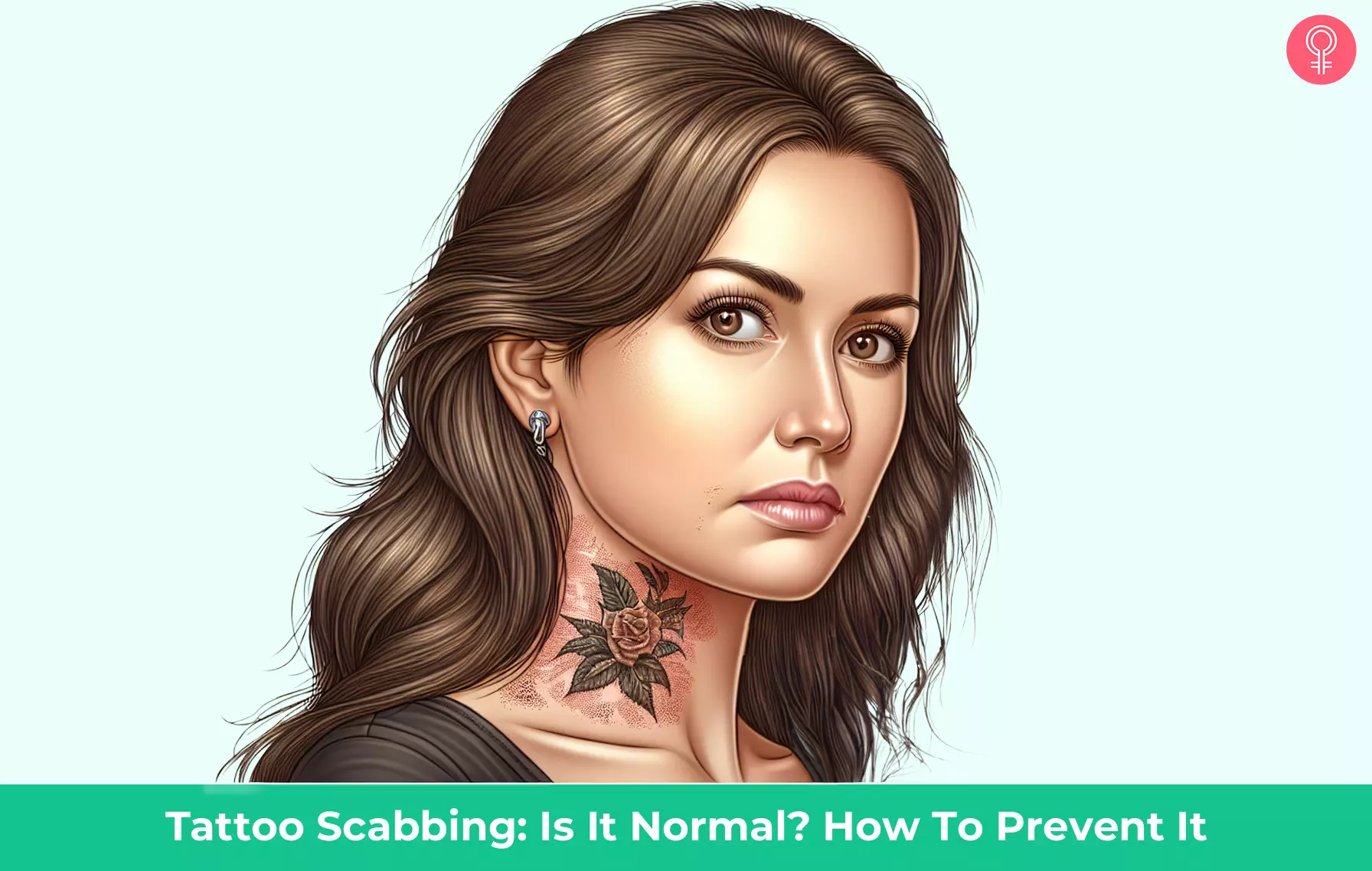
Image: Dall·E/StyleCraze Design Team
If you are tired of the itchiness caused by your healing tattoo and are worried that you might accidentally pull out the still-healing tattoo scabs, then you might want to take a look at the video below. Check it out to learn to properly care for your new tattoo!
Personal Experience: Source
StyleCraze's articles are interwoven with authentic personal narratives that provide depth and resonance to our content. Below are the sources of the personal accounts referenced in this article.
(i). How To Care For A New Tattoo |Pugs And Dinosaurshttps://pugsanddinosaurs.com/2015/07/30/how-to-care-for-your-new-tattoo/References
Articles on StyleCraze are backed by verified information from peer-reviewed and academic research papers, reputed organizations, research institutions, and medical associations to ensure accuracy and relevance. Read our editorial policy to learn more.
- The risk of bacterial infection after tattooing
https://www.ncbi.nlm.nih.gov/pmc/articles/pmc5290255/ - Tattoo-associated viral infections: a review
https://www.ncbi.nlm.nih.gov/pmc/articles/pmc8549973/
Community Experiences
Join the conversation and become a part of our empowering community! Share your stories, experiences, and insights to connect with other beauty, lifestyle, and health enthusiasts.
Read full bio of Brik Rangel
Read full bio of Subhrojyoti Mukherjee
Read full bio of Gazala Firdos Ansari






